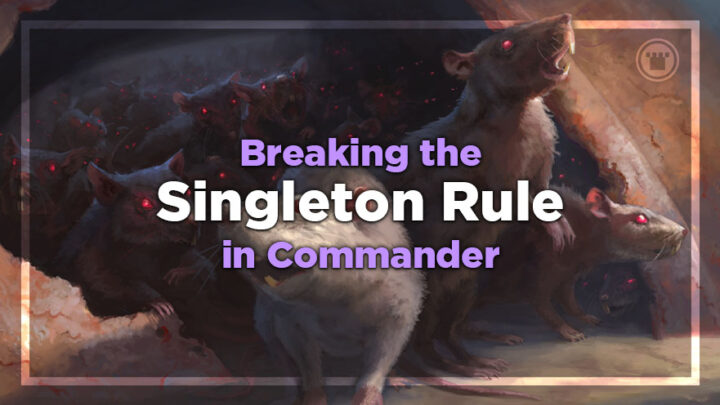There are many features that define Commander as a format – from the social aspects to the power level discussions and the commanders themselves. Perhaps the most outstanding quality Commander has is that it’s a singleton format – though there are some cards and decks that ignore this completely.
There are few cards in Magic that state “A deck can contain any number of cards named X” – and that makes them all the more memorable and unique. These cards each do something different, and they provide a novelty that some players find intriguing and exciting. They tend to be relatively low in terms of power level, but that hasn’t stopped countless players from brewing around them to great success!
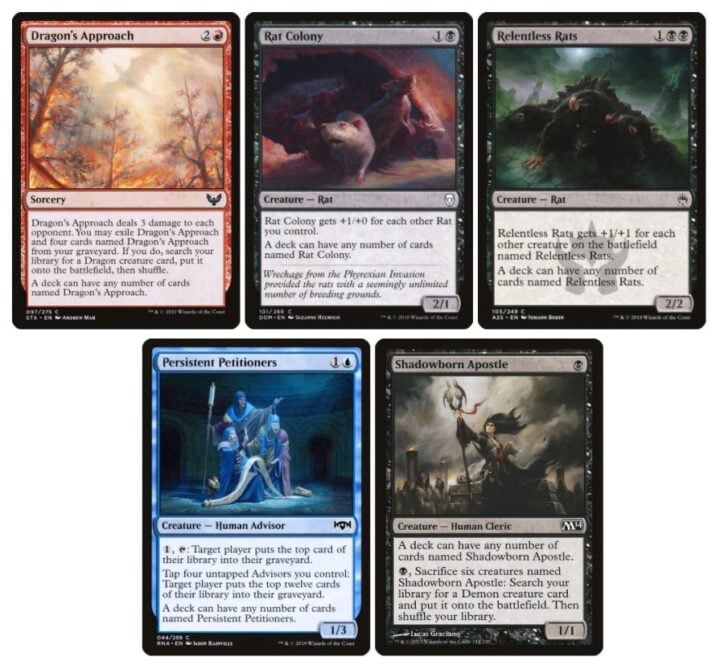
I’m going to cover each one of these cards today, and discuss the supports that can help you get the most from them. I’ll also discuss some cards that will benefit each of them individually, as well as suggestions for synergistic or interesting commanders for each one!
Mutual Benefits
At face value, cards like Persistent Petitioners or Relentless Rats are relatively low-impact; on their own, they don’t provide much value. These decks need to have an abundance of card advantage and mana to keep up with the table, so be generous with your card draw and ramp spells when you’re building a deck around one of these cards!
Some cards can be used in any of these decks, no matter which rule-breaking card you choose to play with. A lot of cards I covered in my article on tribal cards for Commander fall into this category, but there are a few unique ones that most other decks won’t usually use.
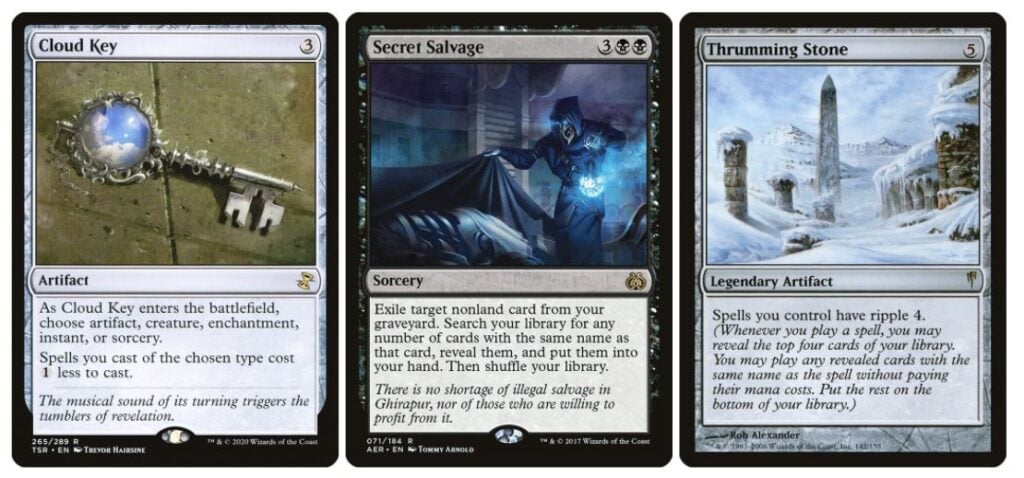
Cloud Key reduces the cost of a specific card type, so you can cast more copies of Dragon’s Approach or Rat Colony in a turn. If your deck has black in its color identity, Secret Salvage can be a great way to fill your hand with additional copies of your key piece. Finally, Thrumming Stone is one of the most explosive cards you can add. If you’re lucky, you can chain several copies of Persistent Petitioners together for one huge turn!
Dragon’s Approach
This Strixhaven burn spell is the most recent of the rule breakers, and easily the most unique. Not only is it the first noncreature spell to be playable in multiples, but it’s the first to use the graveyard as well. Many players want to make something unique with this card, and despite each build having roughly 25 cards in common, they’ve succeeded! Virtually every Dragon’s Approach deck is a blast to play against.
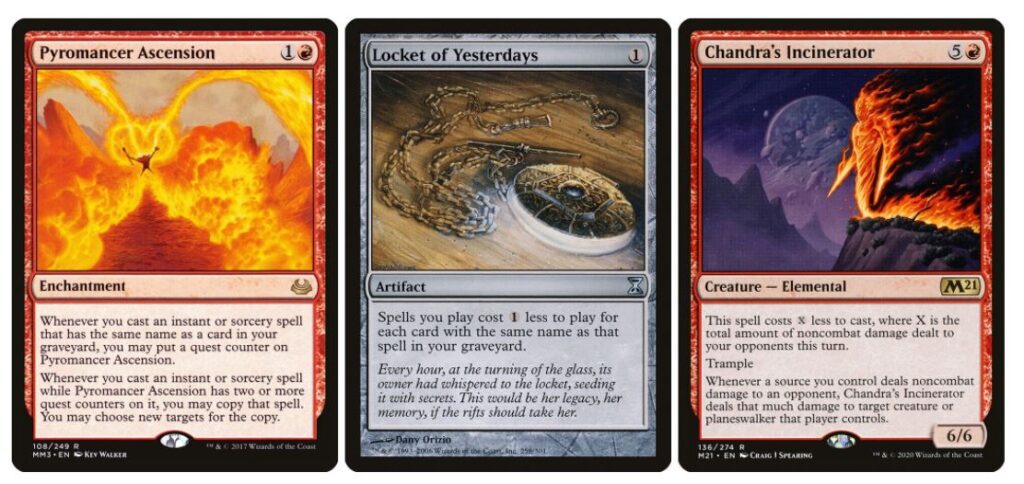
One great thing about Dragon’s Approach is that it’s finally made Pyromancer Ascension relevant in Commander. Once you cast a couple of Dragon’s Approach with this enchantment on board, you’ll be hitting opponents for six damage for each one you cast! It also helps to insulate against counterspells, as opponents will have to counter both copies to prevent you from getting the search effect.
Locket of Yesterdays greatly reduces the cost of Dragon’s Approach. With just two copies in the graveyard, they’ll each cost just one red mana!
Finally, as you’re adding upwards of twenty direct damage spells to the deck, you could find there are fewer slots for cards like removal. Chandra’s Incinerator turns each Approach into a removal spell for each opponent, greatly improving their effectiveness.
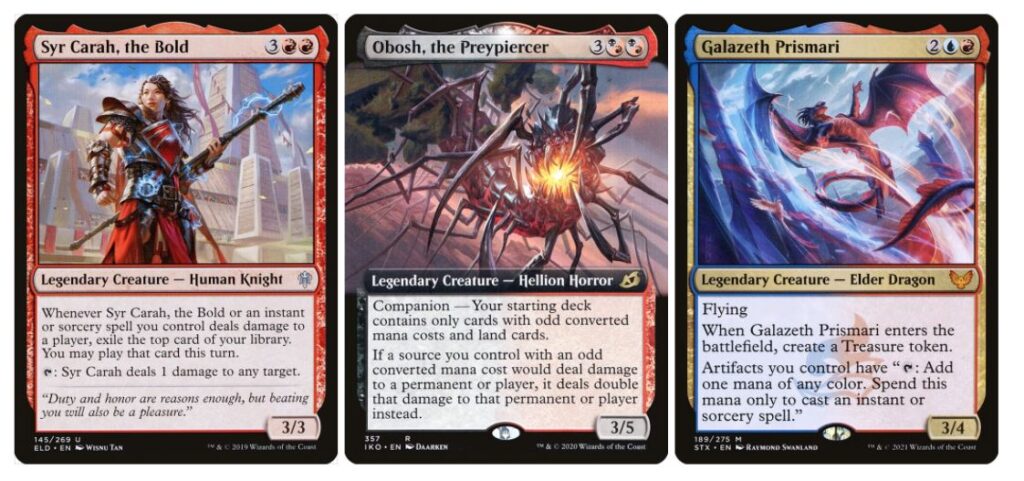
When choosing a commander for your Dragon’s Approach deck, it’s important to consider their ability, as well as the other cards you’ll get access to based on their color identity.
Syr Carah, the Bold is one of the more popular Dragon’s Approach commanders. She effectively draws you three cards for each Dragon’s Approach you cast, and she’s just the card advantage engine you need to keep your deck consistent.
If Burn is your central strategy, Obosh, the Preypiercer can’t be beaten! Three damage to each opponent for three mana is not a great rate, but six damage? That makes them as potent as Lava Spike is in formats like Modern!
If you’d rather lean a bit more into Spellslinger synergies, Galazeth Prismari is a great choice. Blue gives you access to counterspells and powerful card draw, to keep your hand well-stocked. You also get to play Niv-Mizzet, Parun, the smartest and smuggest Dragon! Rachel Weeks, notable brewer and member of the Commander Advisory Group, pilots her fantastic Galazeth Prismari Dragon’s Approach deck regularly on streams, much to the joy and entertainment of both the table and viewers!
Rat Colony / Relentless Rats
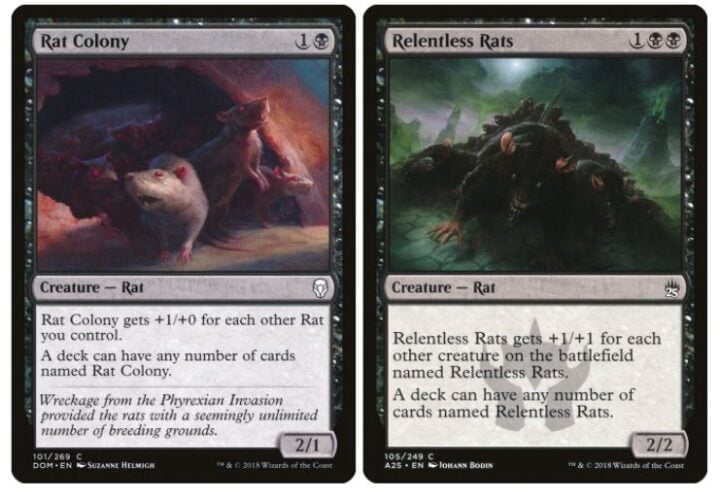
Relentless Rats was the first “A deck can have any number of cards named X” card, which emerged back in Fifth Dawn. Rat Colony is its newer cousin from Dominaria and is much more efficient due to its lower mana cost. Their ability to grow in proximity to additional copies of themselves makes them into potent swarm threats, somewhat similar to Slivers. The two Rats are usually played separately, though some brewers have been known to include both in themed decks!
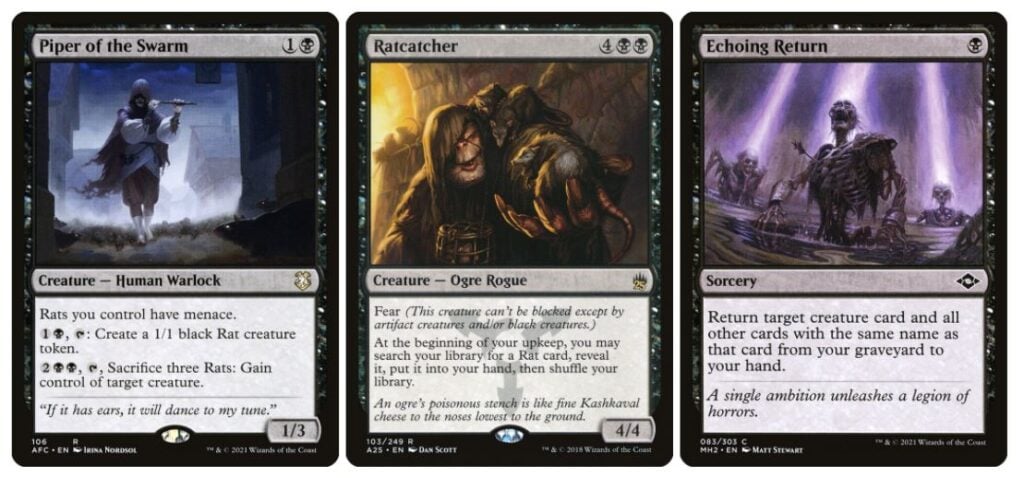
There’s a surprising amount of support for Rats in general. Between Piper of the Swarm and Ogre Slumlord alone, your rats will be virtually unblockable. Ratcatcher is perfect for ensuring you get an extra Rat Colony or Relentless Rats per turn; this will keep growing your board and keeping your hand stocked.
Board wipes are perhaps the single biggest roadblock to this strategy; as these Rats don’t replace themselves, they can often struggle with recovery after a sweeper. Echoing Return is one of the best tools available for the Rats, letting you pull back every single copy from the graveyard. This is often enough to force your opponents to have a second sweeper, or face your w(rat)h!
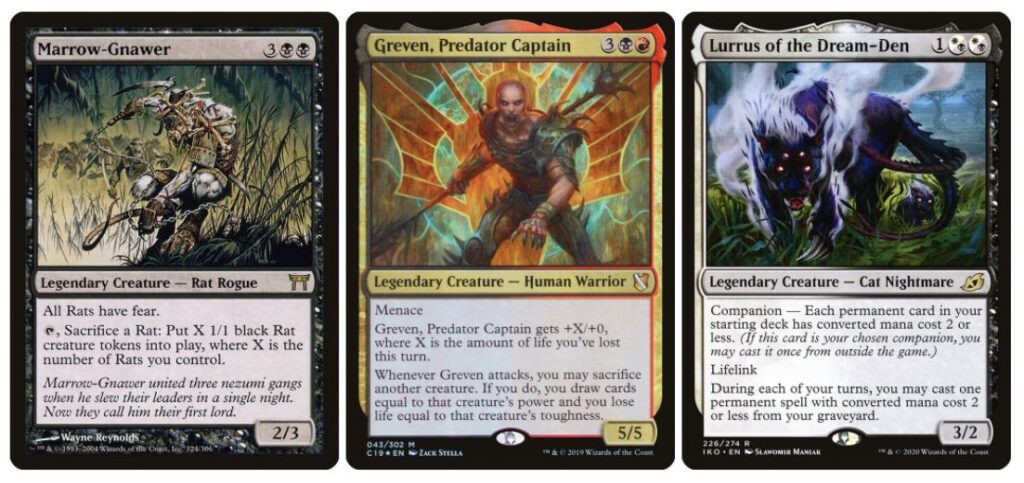
There are quite a few commanders that can provide excellent support for your furry friends. The obvious choice is Marrow-Gnawer, the legendary Rat Rogue from Kamigawa block. They not only grant evasion to your rats, but their activated ability makes them the rodent equivalent to Krenko, Mob Boss.
Greven, Predator Captain might seem like an odd choice, but they’re incredible with Rat Colony in particular. Thanks to Rat Colony’s buff applying only to their power, you can maximize Greven’s card draw ability without losing significant life!
If you’re looking to add white for removal or protection spells, Lurrus of the Dream-Den is a great pick. They can recast a Rat Colony from the graveyard every turn, or pick up any other lost permanents that could help you. It may seem a little off-theme to have a Cat in charge of a bunch of Rats – just try not to think too hard about it!
Persistent Petitioners
Mill is Magic’s Marmite: you either love it or hate it. Personally, I think it’s a fun and interesting way to play the game on an unusual axis, though I can see why players wouldn’t like to see their beloved cards disappear before their eyes.
Persistent Petitioners is a unique take on the archetype; it’s easy to interact with, and it gives players more agency when facing it. With that said, it still has some fantastic tricks up its sleeve to make it fun and engaging!
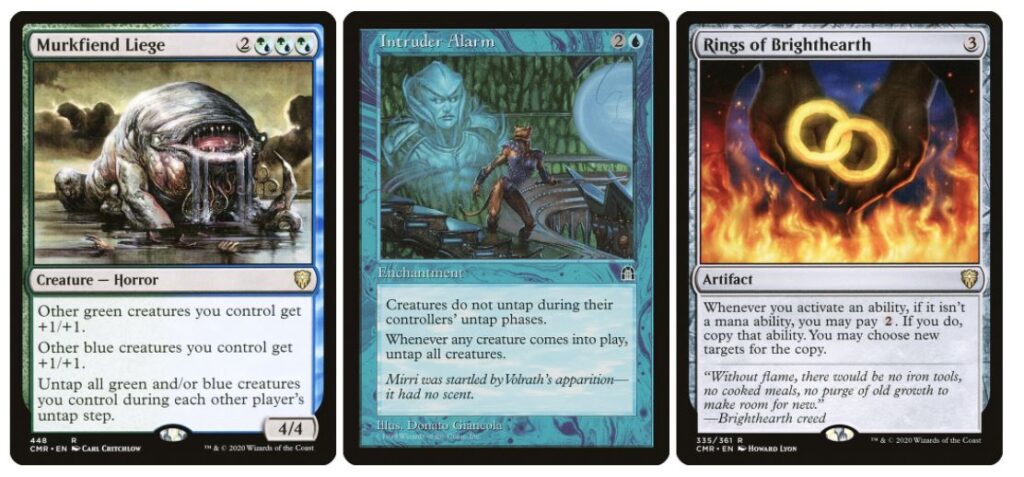
While milling 12 cards may seem like a lot, Persistent Petitioners only targets one opponent at a time. This makes them fairly ineffective by themselves, so they’ll need a little help to really get to work.
Cards that untap them on every turn, like Murkfiend Liege or Seedborn Muse, are perfect for this strategy. They effectively quadruple the Petitioners’ milling capability, giving you a much more impressive clock. Intruder Alarm can be especially dangerous in conjunction with these Advisors, as any creature entering the battlefield will let you tap them again!
If you really want to lean into the mill plan, Rings of Brighthearth will copy Persistent Petitioners’ ability for a small mana investment every time. It’s also one half of a combo that could easily fit in a Petitioners deck; check out my article on budget combos for more details!
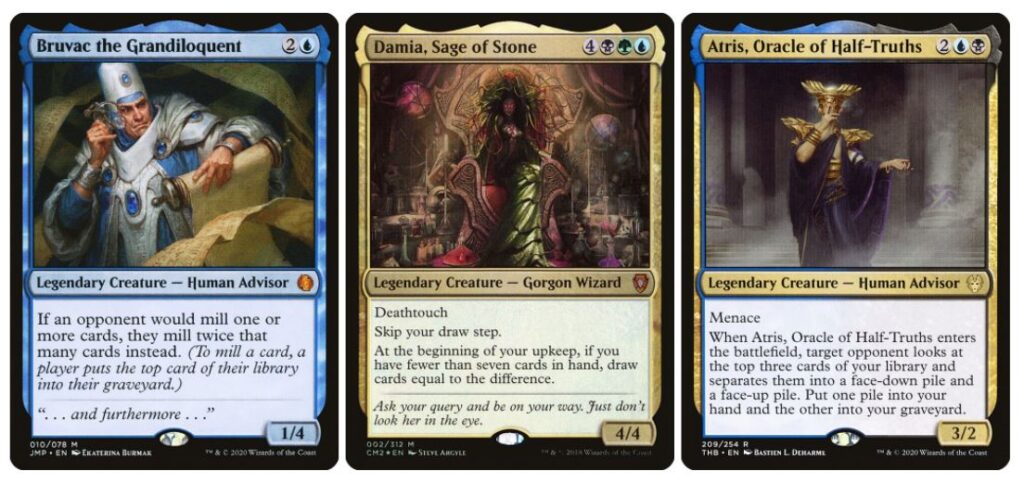
When it comes to commanders, there’s one obvious choice: Bruvac the Grandiloquent. He doubles the effectiveness of the Persistent Petitioners, and makes them into a much more viable option, even at somewhat higher power levels. There is a cost to this, though: Bruvac has a reputation. He’s well-known for being a miserable mill commander when built correctly, and he’ll likely get targeted often.
Damia, Sage of Stone may be my favorite commander for this strategy, as she gives you access to green for both ramp and the aforementioned untap effects, like Seedborn Muse. Additionally, she gives you a powerful card advantage engine in the command zone, ensuring that you’re never short of Petitioners.
If you’d rather lean toward a more casual theme, Atris, Oracle of Half-Truths could be a fantastic choice. While there aren’t many other Advisors in Magic, it still feels much more casual than having Bruvac in the command zone. You can even run Bruvac in the 99 as a fellow Advisor, and your deck will seem much less threatening! You also get access to black for tutors and recursion, and Atris is a neat little card advantage piece that you’ll always have access to.
Shadowborn Apostle
Shadowborn Apostle is the final card on the list, and it’s one of the most interesting to build with. It’s similar to Dragon’s Approach because it’s an enabler, rather than a payoff like Persistent Petitioners or Rat Colony. There are many powerful Demons in Magic (just ask Liliana), and having access to them at any time is a potent ability.
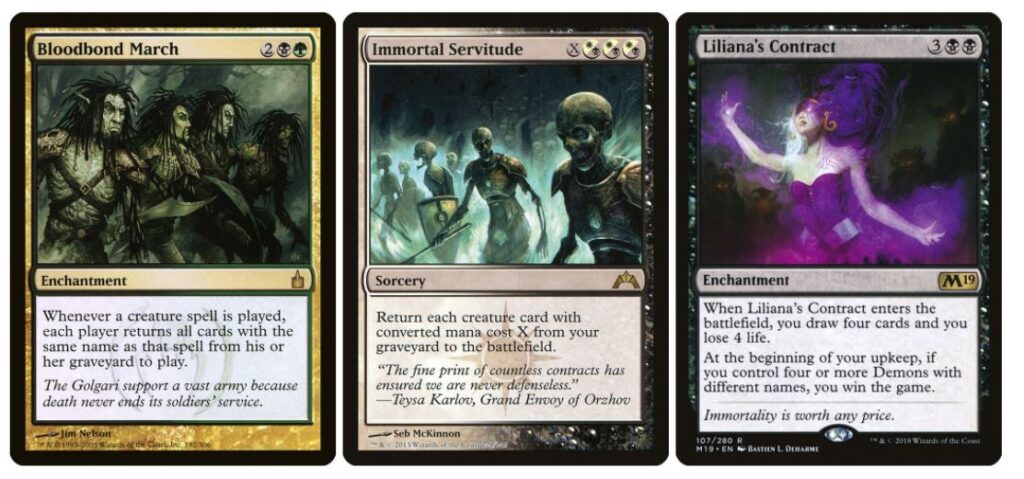
There are two downsides to Shadowborn Apostle: their size, and the number that you need at a given time. They die to almost every piece of removal ever printed, and it can be hard to get six of them on board at any one time. Bloodbond March helps with both of these issues: it will reanimate all copies when you cast another, meaning you’re guaranteed to eventually get enough on board. You can also reuse the sacrificed copies when you play more of them, giving you repeated Demon tutors for as long as you have more Shadowborn Apostles to play.
Immortal Servitude is a great single-use mass-reanimation spell for your tiny Clerics, giving you another use of their search ability. And if you want a flavor win, Liliana’s Contract is perfect for this strategy. You’ll be tutoring for Demons with different names, anyway, so you’ll get a decent card draw spell and an alternate win condition all in one!
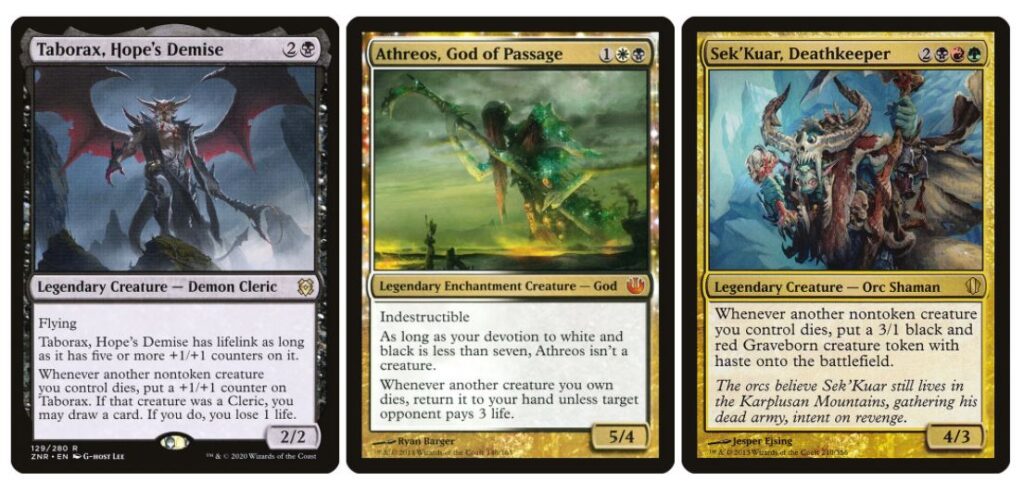
When it comes to commanders, there are a number of different options and color combinations to consider. Taborax, Hope’s Demise is a relatively new commander, but it fits perfectly both in form and function. Not only is Taborax a Demon, but he’s a Cleric, too – same as the Apostles. His triggered ability is also incredibly powerful; you can draw up to six cards when you sacrifice your Shadowborn Apostles, which is a ridiculous amount of advantage for just six life!
Athreos, God of Passage is a super grindy choice, whose ability can whittle down opponents over time, or recur your Apostles for repeated use. You’ll also have access to white, which will give you more versatile removal and protection.
If you’d rather build more aggressively, Sek’Kuar, Deathkeeper is great at pressuring opponents. If you activate Shadowborn Apostle’s ability while Sek’Kuar is on board, you’ll generate a whopping 18 power worth of tokens with haste! Even if you can’t assemble enough Apostles to summon a Demon, you’ll still have enough aggressive tokens to close out the game.
While these quirky cards might not seem to be in the spirit of Commander, they’re a testament to the format’s awesome scope. They’re an official exception to the singleton rule, almost like a predetermined part of all Rule Zero conversations. Players generally like to see them and the unique play they bring to games, and that’s what we all hope for from most of our decks.
Would you build a deck using one of these cards? Do you have a deck like these already? Are there any other commanders or builds you like to run that isn’t mentioned here? I’d love to hear about them! Let me know over on Twitter – I look forward to seeing your brews!

Scott is an Irish content creator and the Head of Budget Magic for the Izzet League. He focuses on affordable decks in Pioneer, Modern, and Pauper, particularly ones that stray from the mainstream. When he’s not writing about his favorite decks, he can be found talking incessantly about them on Twitter and on The Budget Magic Cast.

